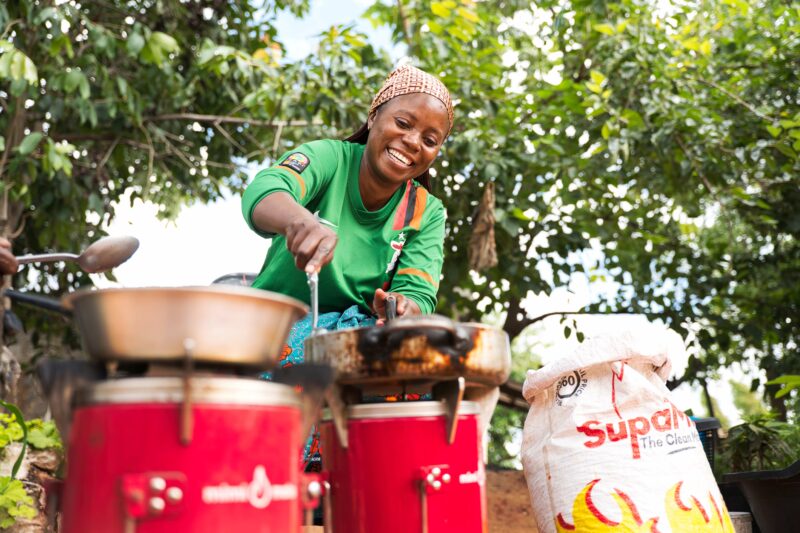24th February 2025
Market Insights: Food loss and waste – how infrastructure supports farmers facing the impacts of climate change.
29th Sep 2024 | Leave a comment | By Ravi Dhanani
Food loss and waste is estimated to account for around half of the 18Gt CO2e emissions linked to the global food system.[i] Not only is this figure huge, but it is almost entirely avoidable if we address the root causes of produce being lost along the value chain as it travels from farm to fork.
A staggering twenty-eight percent of the world’s agricultural land is used to produce food that is lost or wasted.[ii] Prevention is important for the mitigation of climate change as food waste produces damaging methane emissions. It is also critical if communities are to avoid hunger and earn a sustainable income by selling their produce locally, and onwards into the export market, addressing food shortages elsewhere.
As the impacts of climate change become ever-present for farmers in sub-Saharan Africa, I would like to talk about the ways in which access to the right infrastructure along the food supply chain can support farmers to improve their yields, prevent spoilage and theft, and deliver fresh produce to customers that is able to command a fair price for producers.
Let’s start with farming practices
A key challenge for farmers in sub-Saharan Africa is reliance on rain-fed agriculture. As rains fail, shorten, or intensify with the effects of climate change, seasons can no longer be relied upon to set the tempo of planting and harvesting cycles.
Many farmers have turned to diesel fuelled irrigation pumps; however, these are expensive and polluting and can fail due to maintenance issues, interrupted fuel supplies or global prices placing fossil fuels out of farmers’ reach. Solar-powered irrigation pumps such as those delivered by SunCulture, serve to meet the irrigation needs of small-scale farmers and go a step further, using Internet-of-Things enabled technology to ensure that maintenance issues are addressed swiftly. Farmers can also use the systems to charge small devices such as mobile phones and to receive vital real-time weather forecasts and planting advice specific to their local weather conditions.
On a larger scale, InfraCo Africa has supported the Chanyanya and Chiansi projects in Zambia’s Kafue District for almost two decades, demonstrating the value of harnessing farming cooperatives to pool parcels of smallholder land to allow for its irrigation. This irrigated land now supports productive market gardens and profitable commercial farming. Together, the projects have provided capacity to irrigate up to 3,500ha of land. With a reliable supply of water at the right time, crops can flourish all year round.



Coupled with irrigation, it is important for farmers to have access to good quality seed – including disease and drought-resistant varieties – and other farm inputs which are available to buy in local currency. The farmers at Chiansi and Chanyanya have the support of a professional agronomist who has been employed by the company. This support enables farmers to diversify their planting, for example, growing cash crops between their main crops, and to increase overall yields.
Where should the harvest go next?
Once a crop is harvested, it must be stored well to prevent it rotting in the sun or being eaten by rodents and insects between harvest and it being taken to market. Across sub-Saharan Africa, it is estimated that a lack of access to appropriate post-harvest infrastructure – such as cold storage facilities – results in food losses of 30-50%.[iii]
In Malawi, our partner on the Salima and Golomoti Solar plants has supplied Purdue Improved Crop Storage (PICS) bags for farmers as part of its wider Livelihood Restoration Programme. By using these bags instead of hessian sacks and traditional storage methods, food loss has been cut and farmers are able to store their food for longer.
For more perishable crops, our investment into Inspira Farms is addressing ‘last mile’ cold storage for growers of goods such as flowers and fresh fruit. In Kenya, Ghana, Zambia and Zimbabwe, Inspira Farms supplies affordable, energy-efficient cold storage units that can be deployed on farms themselves to rapidly cool produce and keep it fresh ahead of onward transportation. This ‘Cooling-as-a-service’ model has huge potential to enable farmers to store and sell their produce year-round, increasing food security and their climate resilience.
At Equatorial Power, Productive Hubs linked to solar mini-grids allow farmers to add value to their crops by cooling, drying, milling, or processing them, activities which keep food fresher for longer. Access to a Productive Hub and pest-free storage means that wheat, soya, and maize can be stored as flour for the farmers’ own future use, or to sell when market prices are more favourable.
On a larger scale, the Liberia Inland Storage and Distribution Facility offers producers open access to appropriate warehousing for their needs as well as cutting-edge supply chain management systems and secure storage which mitigates against the risk of theft.


Bringing goods to local markets
Farmers need to transport their produce to market as quickly as possible to retain its freshness and command a fair price and yet, to date, consideration of farm to market logistics for smallholders has been largely uncoordinated, leading to avoidable food losses.
There are a number of strands to this issue. Access to markets is often constrained by poor road surfacing which leads to vehicles becoming stuck or breaking down – preventing farmers from reaching markets in a timely fashion. At KIS, this issue was compounded by a lack of safe, affordable ferries linking Bugala Island to mainland Uganda. Addressing these barriers has significantly improved and expanded trade on the island and between the island and the mainland.
Mindful of transport emissions being a key driver of climate change, access to reliable, motorised transport – such as Waterbus passenger ferries on Lake Victoria, or Zembo’s two-wheeler electric boda, bodas in Uganda – is necessary to ensure that produce retains its freshness en route to market.



Mobility for Africa is a prime example of how access to clean, affordable transportation suited to rural terrain is enabling farmers – particularly female farmers – to reach markets more swiftly. With an electric Hamba, riders can transport a greater quantity of produce to market which has encouraged some farmers to grow more.[iv]
Informally, Hamba riders aggregate their crops for sale, an approach that can be a key enabler for accessing larger markets. Mobility for Africa has worked with local dairy authorities to facilitate this practice on a more formal basis. Aggregation is also proving valuable for farmers in rural Malawi where the solar projects’ Livelihood Restoration Programme has established a relationship between local farmers and a large groundnut buyer which accepts agreed quantities of the crop from multiple farmers at a pre-arranged price.

Looking to sell on the export market
If produce is grown at scale, kept at the right temperature or in a form which allows for a longer shelf-life, it is possible for producers to sell their crops further afield, into neighbouring countries and globally, where it can reach an even larger market and command higher prices.
Alongside important legislative initiatives such as the African Continental Free Trade Area (AfCFTA),[v] sustainable transport projects such as the East Africa Marine Transport project – which will shortly link ports in Uganda and Tanzania – are opening up new regional routes. The expansion of Waterbus from Kenya into Uganda and Tanzania will also enable farmers to move produce around the Lake edges and between smaller islands. Customs officials will shortly be seconded by the Liberia Revenue Authority to the Liberia Inland Storage and Distribution Facility where they will manage the bonded section of the warehouse, handling the customs clearance process for imports, and facilitating smoother trade.



Where do we go from here?
We know from our own portfolio that efforts are underway across the continent to roll out access to irrigation – through large-scale canal infrastructure or smaller solar-powered irrigation technology. Farmers are also accessing training in sustainable farming practices and gaining access to vital weather reports and agronomy advice. If delivered at the necessary scale, such initiatives give hope that farmers can maximise their yields even as traditional seasons are inevitably disrupted by climate change.
Implementing solutions around cold- and pest-resistant storage will prevent losses, ensuring that produce reaches consumers at its best and that farmers can maximise profits from their labour.
To access these markets, more work still needs to be done to connect small scale farmers with larger buyers such as restaurants, supermarkets, and wholesalers. This can happen through the use of aggregators as well as cooperative farming practices which maximise the benefits of irrigation and other farm inputs, and open-access storage that allows smaller scale farmers to store their produce correctly – avoiding food loss and waste as well as other challenges associated with insecure storage, such as theft.
Transport is another important piece of the puzzle – with clean, safe, and reliable transport farmers can transport their produce to markets swiftly and gain access to wider regional and international markets which have previously been dominated by commercial-scale farmers. To really shift the needle, transport emissions must be minimised through the use of solar-powered electric vehicles, new maritime fuels, and solar-boost technology – and connecting infrastructure such as roads, need to be maintained to acceptable standards.
Finally, we all need to take responsibility for food waste at a household level, although less prevalent in sub-Saharan Africa, food waste at the point of consumption is a huge issue globally.[vi] Here too, there are increasing efforts to use unavoidable food waste for energy production or the industrial-scale production of compost to nourish the land that grows the produce which will enter those same supply chains and markets in the future. A true example of the circular economy at work.
[i] Food waste makes up ‘half’ of global food system emissions – Carbon Brief
[ii] Sutton, William R.; Lotsch, Alexander; Prasann, Ashesh. 2024. Recipe for a Livable Planet: Achieving Net Zero Emissions in the Agrifood System. Agriculture and Food Series. Conference Edition. © Washington, DC: World Bank. http://hdl.handle.net/10986/41468 License: CC BY 3.0 IGO.
[iii] Our impact | ESG | InspiraFarms©
[iv] Adefi-Mtambo.pdf (infracoafrica.com)
Leave a Reply
Related projects

Zambia: Chiansi
Scaling up smallholder access to irrigation









